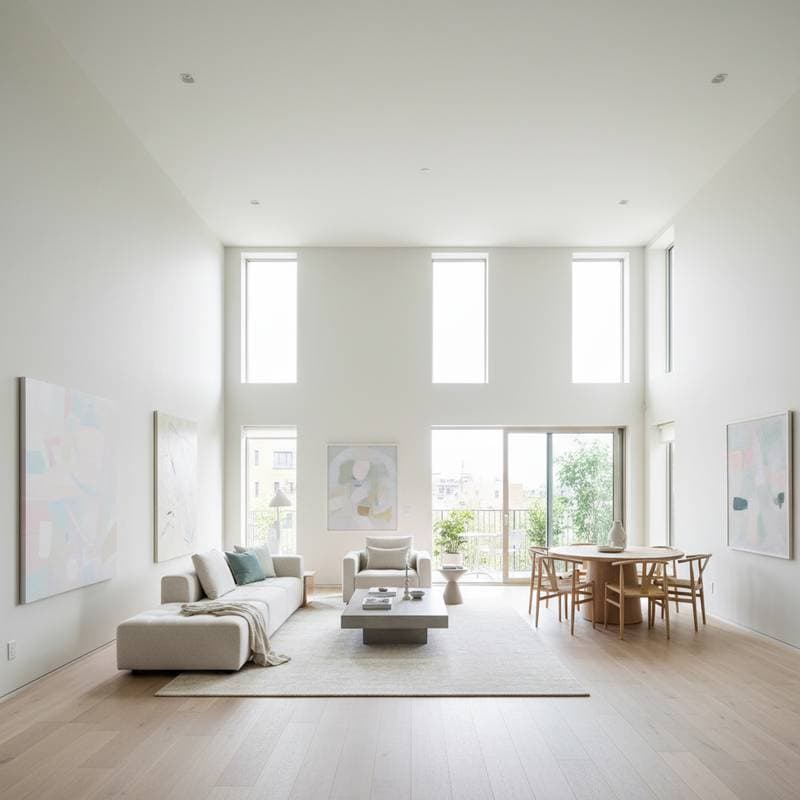Understanding LRV for Enhanced Home Illumination in 2025
Many homeowners seek ways to make interiors feel more expansive and luminous, particularly in compact or dimly lit areas. Light Reflective Value, or LRV, provides a precise measure to achieve this effect. By focusing on LRV during paint selection, individuals can transform ordinary rooms into welcoming, light-filled environments that promote comfort and visual appeal.
Defining Light Reflective Value
LRV quantifies the percentage of visible light that a paint color reflects back into a space, ranging from 0 for absolute black, which absorbs all light, to 100 for pure white, which reflects it entirely. Colors with higher LRV values, such as soft whites or pastels above 70, distribute light evenly, fostering a sense of openness. In contrast, lower LRV shades below 30, like deep charcoals, retain light and create intimate, dramatic atmospheres suitable for accent walls.
This metric extends beyond mere brightness; it interacts with a color's undertone and the room's orientation. For instance, a high-LRV neutral in a north-facing room maintains warmth without appearing stark, ensuring balanced illumination throughout the day.
The Impact of LRV on Home Design and Functionality
LRV influences not only aesthetics but also practical aspects of living spaces. In smaller rooms, paints with LRV values exceeding 75 can minimize visual clutter by reflecting light to soften edges and elevate perceived height. For areas with limited natural light, such as basements or interior hallways, selecting mid-range LRV colors around 50 to 60 introduces subtle brightness without overwhelming the palette.
Energy efficiency benefits emerge as well, since reflective surfaces reduce reliance on artificial lighting. Homeowners may lower bulb wattage or eliminate unnecessary fixtures, contributing to modest utility savings. Additionally, strategic LRV use enhances architectural features; pairing high-LRV walls with medium-LRV trim defines boundaries sharply, ideal for photography or real estate presentations.
Designers often recommend considering LRV alongside furniture and decor. Reflective paints amplify the glow from metallic accents or glossy surfaces, creating layered depth that evolves with seasonal light changes.
Strategies for Selecting Optimal LRV Levels
Effective paint choices require evaluating a room's unique conditions. Begin by assessing natural light exposure: north-facing spaces benefit from warm tones with LRV above 70, such as creamy ivories, to counteract cooler shadows. South-facing rooms accommodate cooler grays or blues with LRV from 60 to 80, leveraging abundant daylight for vibrant results.
Testing remains essential for accuracy. Apply samples to a 2-by-2-foot area on multiple walls and observe under varied lighting conditions—morning sun, midday glare, and evening lamps. This reveals how LRV performs dynamically, preventing surprises during full application.
Finish selection complements LRV: matte surfaces diffuse light softly for a velvety look, while satin or semi-gloss options enhance reflection, making high-LRV colors appear more radiant. For ceilings, opt for LRV values over 80 in flat finishes to draw the eye upward and expand vertical space.
Incorporate surrounding elements by coordinating with floors and furnishings. Dark hardwood floors pair well with high-LRV walls to balance contrast, while light rugs amplify overall reflection. Consult paint swatches from reputable brands to identify exact LRV figures, ensuring harmony across the scheme.
Achieving Brightness Across Budget Ranges
High-LRV transformations require no extravagant outlays; targeted updates yield significant improvements. At a low investment level, refresh walls with a durable high-LRV white or light neutral, such as a soft linen shade with LRV near 85. Proper surface preparation—cleaning, priming, and patching—maximizes the paint's reflective potential without additional costs.
For moderate budgets, introduce dimension by painting walls in a high-LRV base and trim in a complementary mid-LRV tone around 50. Replace heavy window treatments with sheer curtains to allow more light penetration, enhancing the paint's effect. This approach refreshes outdated spaces efficiently, often completing in a weekend.
Higher investments integrate paint with infrastructure upgrades. Install recessed lighting or LED strips that accentuate reflective walls, and apply semi-gloss to trim for superior light bounce. These enhancements not only brighten rooms but also increase property value through modern, efficient design.
Regardless of spend, prioritize quality paints with low VOCs for health and longevity. Professional application ensures even coverage, preserving LRV benefits over time.
Integrating LRV for Enduring Home Comfort
Adopting LRV as a selection criterion shifts perspective on interior design, revealing opportunities to optimize everyday spaces. Morning areas gain inviting warmth from balanced reflection, while passages feel less confining. Artwork and personal items stand out against thoughtfully chosen backgrounds, enriching the living experience.
Ultimately, LRV empowers homeowners to harness light for functional and emotional benefits. Through informed choices, interiors evolve into serene, expansive retreats that support well-being year-round.



